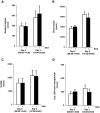Acetaminophen elimination half-life in humans is unaffected by short-term consumption of sulfur amino acid-free diet
- PMID: 20207720
- PMCID: PMC2879925
- DOI: 10.1124/jpet.110.166439
Acetaminophen elimination half-life in humans is unaffected by short-term consumption of sulfur amino acid-free diet
Abstract
Sulfation and glutathione (GSH) conjugation are important pathways for elimination of acetaminophen (APAP). Previous studies in rodents show that limitation of dietary sulfur amino acids (SAAs) reduces biosynthesis of 3'-phosphoadenosine-5'-phosphosulfate, the precursor for sulfation, and GSH, the precursor for the mercapturatic acid pathway. The amount of SAA needed for the metabolism of two doses of APAP is equivalent to 62% of the recommended dietary allowance (RDA) for SAA in humans. A decrease in the activity of these metabolic pathways could lead to decreased elimination of the reactive metabolite of APAP and possibly affect risk of APAP use. To determine whether intake of a SAA-deficient diet alters APAP metabolism, a pilot clinical study with a double-blind, cross-over design was performed. Subjects received the RDA for SAA for 3 days for equilibration. After admission to the clinical research unit, subjects were given a chemically defined diet with 100 or 0% of the RDA for SAA for 2 days. On day 3, two doses of APAP (15 mg/kg) or placebo were given successively within a 6-h interval. Plasma samples were collected at baseline and hourly for 12 h, and two 6-h urine aliquots were collected during this time course. The data show that SAA limitation 1) did not change the pattern of APAP metabolites in plasma or urine and 2) did not alter APAP pharmacokinetics. Thus, the results show that 2 days of diet completely devoid of SAA have no effect on APAP metabolism or disposition in healthy humans.
Figures




References
-
- Andrews RS, Bond CC, Burnett J, Saunders A, Watson K. (1976) Isolation and identification of paracetamol metabolites. J Int Med Res 4 (Suppl 4):34–39 - PubMed
-
- Brodie BB, Axelrod J. (1948) The fate of acetanilide in man. J Pharmacol Exp Ther 94:29–38 - PubMed
-
- Chen C, Hennig GE, Manautou JE. (2003) Hepatobiliary excretion of acetaminophen glutathione conjugate and its derivatives in transport-deficient (TR−) hyperbilirubinemic rats. Drug Metab Dispos 31:798–804 - PubMed
-
- Essex DW, Li M. (2003) Redox control of platelet aggregation. Biochemistry 42:129–136 - PubMed
Publication types
MeSH terms
Substances
Grants and funding
- R03 ES012929/ES/NIEHS NIH HHS/United States
- K24-RR023356/RR/NCRR NIH HHS/United States
- M01-RR00039/UL1 RR025008/RR/NCRR NIH HHS/United States
- ES012929/ES/NIEHS NIH HHS/United States
- TL1 RR025010/RR/NCRR NIH HHS/United States
- TL1-RR025010/RR/NCRR NIH HHS/United States
- TL1 TR000456/TR/NCATS NIH HHS/United States
- UL1 TR000454/TR/NCATS NIH HHS/United States
- R01 ES009047/ES/NIEHS NIH HHS/United States
- UL1 RR025008/RR/NCRR NIH HHS/United States
- R03 DK066008/DK/NIDDK NIH HHS/United States
- ES009047/ES/NIEHS NIH HHS/United States
- K24 RR023356/RR/NCRR NIH HHS/United States
LinkOut - more resources
Full Text Sources
Medical

